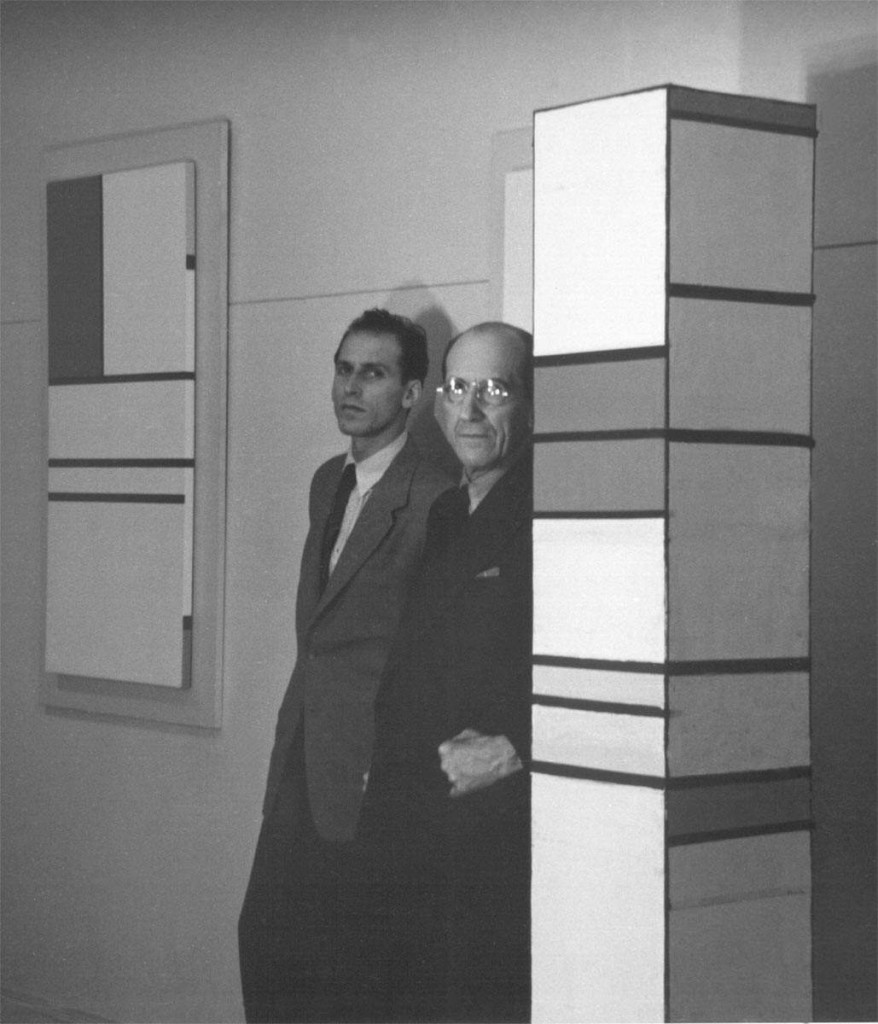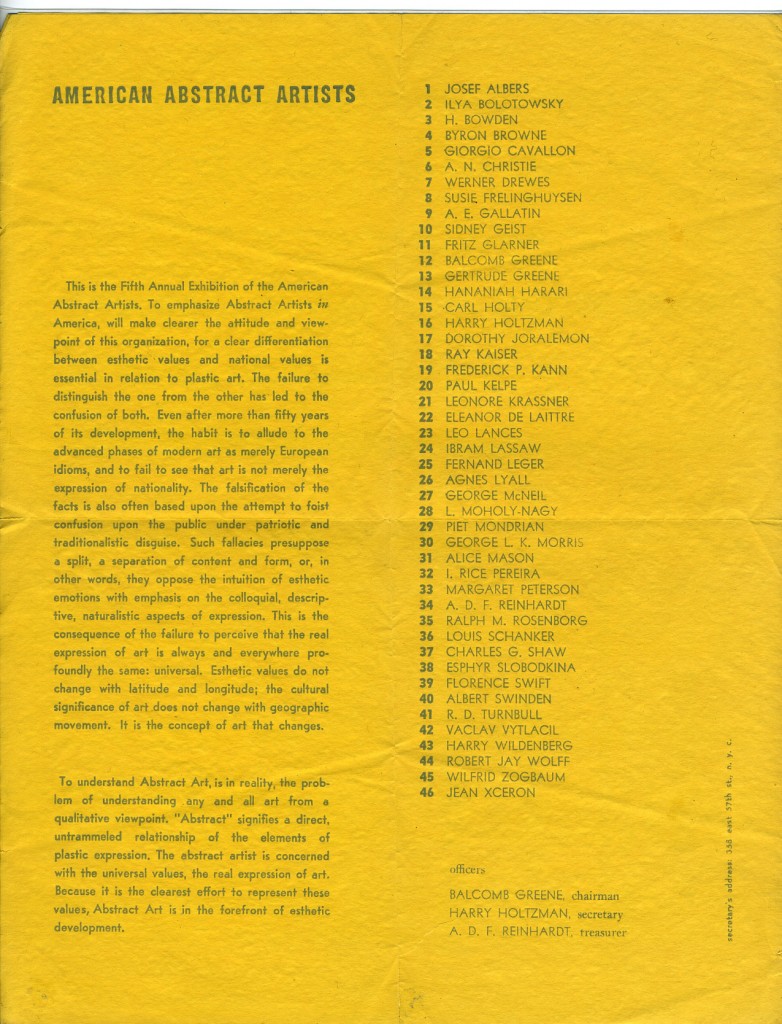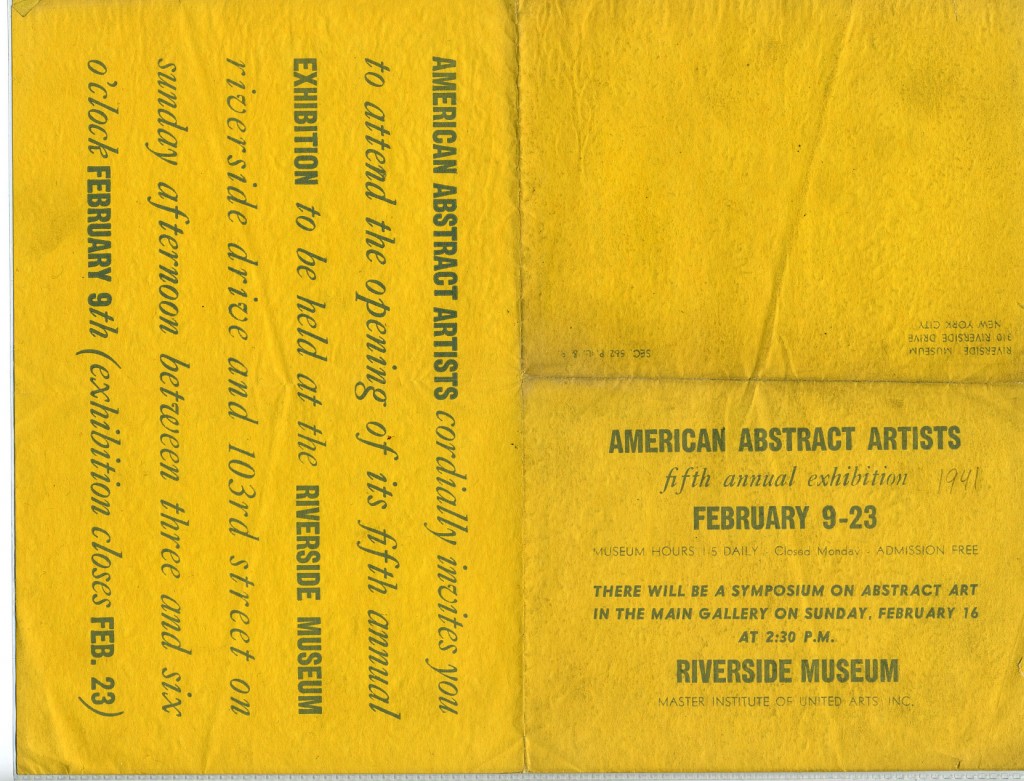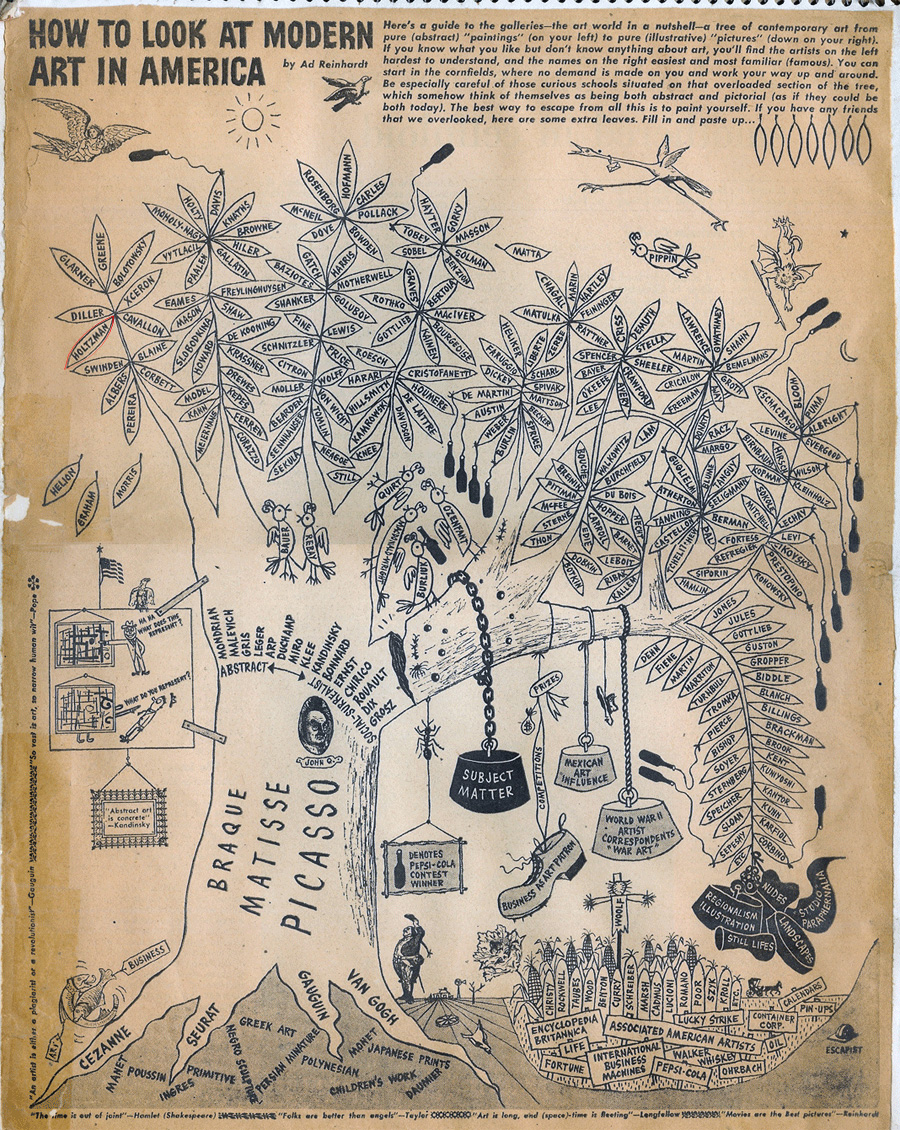Harry Holtzman (1912-1987) 100th Birthday Celebration 1912-2012
(Image: from left to right: Harry Holtzman standing with Piet Mondrian, Holtzman’s studio, New York City, 1941) Image copyright, Estate of Harry Holtzman 2012
Harry Holtzman was an abstract painter, teacher, close friend and authority on the work of the Dutch artist Piet Mondrian and was co-editor of ”The New Art – The New Life,” a book of Mondrian’s collected writings, published in 1986.
In the mid-1930’s, concerned over the lack of opportunity for abstract artists to discuss and exhibit their work, Mr. Holtzman helped to found the American Abstract Artists, an influential organization whose shows and publications espoused the principles of European modernism.
Involved with abstract painting since 1930, Mr. Holtzman found a kindred spirit in Mondrian, whose hard-edged rectilinear forms in primary colors he first saw here in 1933. At the age of 22, he made a pilgrimage to Paris to meet the older artist, and established a lasting friendship with him. In 1940, shortly after the outbreak of World War II, he sponsored Mondrian’s immigration to this country and contributed to his support. After Mondrian’s death from pneumonia in 1944, as a tribute to Mondrian, and now as his executor, Holtzman, opened his studio at 15 East 59th Street, New York City for six weeks to interested people and friends. Holtzman and artist friend Fritz Glarner photographed his studio in black-and-white and color. (The Studio becoming known as an important work of art in itself, know as “The Wall Works”)
Born June 8, 1912, in New York City, Mr. Holtzman studied at the Art Students League, where he was a studio assistant to Hans Hofmann, a famous painter and teacher. When Hofmann established his own school, Mr. Holtzman taught there from 1932 to 1935. In the mid-30’s, he also worked as a supervisor of abstract artists in the mural division of the Federal Art Project. ”My chief effort was to see that everyone had supplies and also to encourage them not to finish their work too quickly,” Mr. Holtzman wrote in the Emerson Gallery catalogue.
From 1950 to 1975, Mr. Holtzman was an associate professor of art at Brooklyn College. In the early 1960’s, on an extensive trip through southern India, he discovered a number of villages where powerful primitive sculptures of local gods were being produced. He photographed the sites and then arranged for a number of exhibitions in the Uniteds States. He also lectured extensively throughout the world on the work and theories of Mondrian.
By Gracee Glueck
-The New York Times
Aside from spending over 40 years dedicated to the writings and teaching of the work of Piet Mondrian, and his theories, Holtzman’s own work, and paintings were very prolific and in many ways went beyond the ideas and theories of the abstract “neoplastic” work of Mondrian into a more spacial 3 dimensional realm.
Mondrian himself, commented on Holtzman’s work (Sculpture-Painting from 1941-42):
“In the present three dimensional works of H.H. (Harry Holtzman) the picture moves still more from the wall into our surrounding space. In this way the painting more literally annihilates the three dimensional volume.” -Piet Mondrian
Harry Holtzman:
Harry Holtzman (1912-1987) was an American artist and founding member of the American Abstract Artists group.
Contents[hide] |
[edit] Early life
At the age of fourteen, Holtzman visited the Société Anonyme’s 1926 “International Exhibition of Modern Art” at the Brooklyn Museum and developed an early interest in advanced art with the guidance and encouragement of a high school teacher.
At sixteen, in 1928, he began attending the Art Students League of New York and became an active participant in League activities, serving as a monitor and contributing to the quarterly magazine. At a membership meeting in early 1932, Holtzman’s remarks against the xenophobia of the League’s director were instrumental in carrying a membership vote that brought George Grosz and Hans Hofmann to teach at the League. At the close of this meeting, Burgoyne Diller, a Hofmann protege, taken by Holtzman’s independence of mind, introduced himself, beginning an important lasting relationship.
By January 1934, Holtzman recalls,
“…in my completely independent development I’d struck in a direction, which without knowing it, was taking me in a direction similar to Mondrian. One day Diller was seeing some works in my studio… He asked me if I had seen the recently opened Museum of Living Art (A.E. Gallatin’s collection at the New York University library on Washington Square. I hadn’t. I went. This was the first clue I had to Mondrian’s perception, the two paintings thatGallatin had acquired…”
In the ensuing months, Holtzman “became obsessed with not only the paintings of Mondrian, but with the idea that the man had to think certain things about historical transformation, the values and functions of art. I really had to go toEuropeto speak with him.”
By the end of November, Holtzman had raised enough money to pay for passage to France. In mid-December he introduced himself to Mondrian in the Dutch artist’s Paris studio. Despite a language barrier and an age difference of forty years, the two men became good friends during the four months of Holtzman’s stay in Paris.
When Holtzman returned to New York City in 1935, he joined the WPA Federal Art project, but was first assigned to write for the public relations department, since his art was considered too extreme for public placement. When Diller was promoted as managing supervisor of the Mural Division in New York, he appointed Holtzman as his assistant supervisor in charge of the abstract mural painters. In 1936 Holtzman was instrumental in bringing together the nucleus of painters and sculptors who established the American Abstract Artists in 1937. Although he opposed the group’s emphasis on exhibitions, and the attempts of certain influential members to exclude all but “pure-abstractionists”, Holtzman maintained as active role for several years, serving as secretary in 1938 and again in 1940 and arranged for the three-week AAA exhibition and its educational component at the American Art Today Building of the New York World’s Fair in 1940, directed by Holger Cahill.
[edit]New York during WWII
During the German Blitz of London in 1940, Holtzman arranged for Mondrian to come to New York, where he arrived that October. Holtzman rented an apartment-studio for him, and during the next three and a half years he was one of Mondrian’s most intimate associates. Of a work by Harry Holtzman now in the collection of the Yale UniversityArtGallery, Mondrian commented,
“In the present three dimensional works of H.H. (Harry Holtzman) the picture moves still more from the wall into our surrounding space. In this way the painting more literally annihilates the three dimensional volume.”
As executor of Mondrian’s estate, Holtzman continued his involvement with Mondrian’s art and in 1983 he co-edited a volume of Mondrian’s complete essays.
[edit] Post-war
In 1947, Holtzman became a faculty member of the Institute for General Semantics, where he taught with Alfred Korzybski until 1954. Later he edited the journal Trans/Formation: Arts, Communications, Environment. For many years he participated in the conferences of the National Committee on Art Education of The Museum of Modern Art, and from 1950 to 1975 he was a faculty member of the art department at Brooklyn College, City University of New York. Holtzman lived and worked in Lyme, Connecticut. He is survived by his three triplet children, Madalena, Jackie, and Jason Holtzman, and their mother, artist Betsy McManus.
[edit] From-MOMA show-’95-’96-catalogue
* 1939: After England declares war on September 3, 1939, Mondrian flees his studio in Hempstead and stays with Ben Nicilson and Barbara Hepworth in Cornwall, where they have just fled. Holtzman writes from New York insisting that he come, sending money and promising to find lodgings. * 1940: June 26, Dutch passport stamped with exemption from military service and permission to leave the country.
- August: with Holtzman’s help, he receives an American visa. As soon as Mondrian gets a place in the Dutch immigration quota,
he packs his paintings and sends them toAmerica.
- September 9: two days after the blitz begins, a bomb hits the other side ofParkhill Roadseveral houses away, breaking his windows and thus forcing him to leave. For the rest of the time he lives at the Ormonde Hotel inLondon.
- September 13: writes farewell letters to Nicholson, Hepworth, and Winfred Nicholson.
- September 21: boards ship inLiverpool, but does not leave until two days later because of the blitz.
- October 3, 1940: Mondrian arrives in New York: Holtzman is waiting on the pier and takes him to the Beekman tower on east 49th St., where Mondrian spends his first few days. Knowing his passion for jazz, Holtzman almost immediately plays some recordings of boogie-woogie music, a rhythmically propulsive form of piano blues then enjoying a popular revival, which Mondrian, Holtzman will recall, finds “Enormous, enormous”.
Holtzman takes Mondrian to his summer home in the Berkshires to recuperate from the journey, then finds him an apartment on the third floor of 353 east 56th st., on the corner of first ave. Holtzman will pay the rent and buy him a bed and after Mondrian resists for several months, a record player.
p.2-hh-new art-new-life:
p.5-6-hh-new-art-new-life:bottom… In New York, unless I was away from the city, we saw each other almost every day to discuss our work and ideas. It was also my privilege to help Mondrian put his writing into “correct” English.
Although I have no direct knowledge, early photos and self-portraits of Holtzman show him as somewhat romantic in appearance, then dapper, energetic, proud and lively. Mondrian was among the first in Europe to write about the importance to modern culture of black American jazz and its dances, which he thoroughly enjoyed until the end of his life. In Paris he had a large collection of jazz discs. On the night Mondrian arrived in New York, I introduced him to the boogie-woogie piano music of Ammons, Johnson, and Lewis. His response was immediate, he clasped his hands together with obvious pleasure, “Enormous! Enormous!” he repeated! He often went with me and others to enjoy what he called a “dancing party.” Nobody has ever written more brilliantly about the symbolic ambiance of the night club. (“Jazz and Neoplastic”,1927).
1944: Mondrian dines with Holtzman on 19 January. The two have lately been discussing plans for an ideal nightclub.”
Sadly Mondrian passes away from pneumonia on February 1, 1944.
[edit] References
- Abstract painting and sculpture in America1927-1944 / Museumof Art, Carnegie Institute Pittsburgh in Association with Harry N. Abrams, Inc. Publishers, New York, 1983, pp.175-177 ISBN 0-8109-1805-6
- Mondrian, Piet, Harry Holtzman, ed., and Martin S. James, ed. The New Art – The New Life: The Collected Writings of Piet Mondrian. New York: Da Capo Press; Reprint edition (April 1993) ISBN 0-306-80508-1
[edit] External links
| Wikimedia Commons has media related to: Piet Mondriaan |
- Mondrian Trust, the official holder of reproduction rights to Mondrian’s works.
- Current exhibition exhibiting Holtzman’s Sculpture-Painting from 1941-42, The Société Anonyme: Modernism forAmerica. Collection organized by theYaleUniversityArtGallery. See link: then hit ‘enter site’ button/artists/artist biographies/Harry Holtzman
- Jason Holtzman, Harry Holtzman’s son, Jason Holtzman, the official contact for The Estate of Harry Hotzman.
- PietMondrian.net, the official holder of reproduction rights to Mondrian’s works.
- American Abstract Artists Group , Official Link to The American Abstract Artists group website, Harry Holtzman, Was one of the founding members of the American Abstract Artists Group, in 1936.
- http://www.betsymcmanus.net Harry Holtzman wife, and artist. Living in Chester, Connecticut.
| Name | Holtzman, Harry |
| Alternative names | |
| Short description | |
| Date of birth | 1912 |
| Place of birth | New York City |
| Date of death | 1987 |
| Place of death | At his home, in Lyme Connecticut |
Retrieved from “http://en.wikipedia.org/w/index.php?title=Harry_Holtzman&oldid=449704045”
Holtzman as professor and educator:
Harry Holtzman was one of the founders of the American Abstract Artist group in New York City.
In 1936 Holtzman was instrumental in bringing together the nucleus of painters and sculptors who established the American Abstract Artists in 1937
Brochure from the 5th Annual American Abstract Artist Exhibition in 1941, shows a list of names of some the early pioneers in abstract art:
Holtzman was part of a relatively small, but growing group of artist and architects that help inspire the beginnings of the Abstract Art scene in America and the world.
Below, is a fun illustration by Holtzman’s artist friend Ad Reinhardt titled
“How to Look at Modern Art in America”: From PM Magazine, 1946:
For further information and comments please email: info@harryholtzman.com
or call +(usa) 917.720.3152



